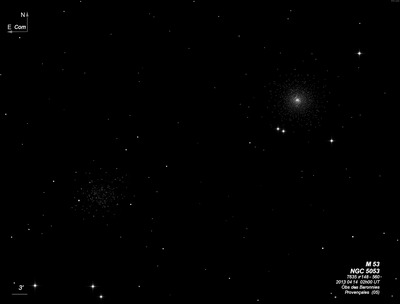
Johann Elert Bode discovered M53 = NGC 5024 = h1558 on 3 Feb 1775. Charles Messier independently discovered it on 26 Feb 1777.
William Herschel made his first observation on 30 May 1783 with his 6-inch and noted "more than a suspicion of stars." On 14 Mar 1784 (sweep 170) he described M53 as "one of the most beautiful objects I remember ever to have seen in the heavens; The cluster appears under the form of a solid ball consisting of small stars quite compressed into one blaze of light, with a great number of loose ones surrounding it and distinctly visible in the general mass. See fig. 2 [which shows it resolved into numerous stars]."
John Herschel described it on 6 May 1826 as "A most beautiful highly compressed cluster. Stars very small, 12...20m; with sc st to a considerable dist; irreg R, but not globular. Comes up to a blaze in the centre; indicating a round mass of pretty equable density." On 25 May 1827, he logged "Seen by Mr. Baily. A fine compressed cluster, with curved appendages like the short claws of a crab running out from the main body."
Wilhelm Struve found it again in 1825 or 1826 and included it in a list of 9 "Nebulae dectae" in the appendix to his main catalogue of double stars. In his 1844 Bedford Catalogue, William Smyth called M53 a "brilliant mass of minute stars" and a "ball of innumerable worlds."
300/350mm - 13.1" (5/21/82): outer halo of faint stars resolved.
400/500mm - 17.5" (5/27/00): at 220x this moderately bright GC appeared 6'-7' diameter with a very bright 2' core and ~50-60 stars resolved. At 380x, perhaps 75 stars were resolved, mostly in the outer halo and the edges of the small, bright, concentrated core. A brighter mag 12 star is just NE of the core, but most of the resolved stars are mag 13.5-15. The halo is fairly rich, but unevenly distributed with more stars resolved on the north side. Towards the edges of the halo the globular thins out and appeared straggly, with a maximum diameter 8'-9'.
17.5" (5/10/86): at least 50 stars resolved mostly in the outer halo which reaches 6' diameter. Contains a very bright core that is very mottled. Many stars are superimposed over the core.
Notes by Steve Gottlieb